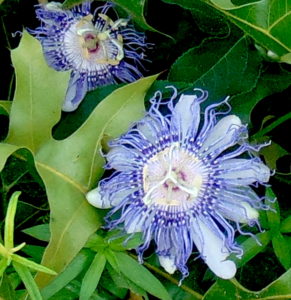 Pictured is a Purple Passionflower
Pictured is a Purple Passionflower
We have bantering pictures of Animals, Birds, Flowers nonprofessional photography. Here is some information from the web about the Purple Passionflower.
Alternate Names Wild passion flower, maypop, apricot vine, old field apricot, Holy-Trinity flower, molly-pop, passion vine, pop- apple, granadilla, maycock, maracoc, maracock, white sarsaparilla.
Uses One of the uses of the purple passionflower is ornamental in nature. This is because of their showy blooms and their climbing ability over fences, arbors, or up walls. Native American Indians used the poultice root for boils, cuts, earaches and inflammation. Dried leaves boiled with water also aids in insomnia.
Wildlife Purple passionflower attracts butterflies. Young tendrils inch lavender flowers are short-stalked from leaf axils. The petals and sepals subtend a fringe of wavy or crimped, hair-like segments. The pistil and stamens are also showy. Three-lobed, deciduous leaves are dark-green above and whitish below. The plants bloom from June to September. The pulpy fruit or “maypop” develops in two to three months after flowering and may be harvested from July to October. It will be yellowish in color and it is about the size of a large oval hen’s egg.
Establishment The purple passionflower requires direct sunlight for at least half of the day and prefers fertile, well-drained soil although it will grow in heavier clay soils. Plants may be propagated from seed or by cuttings. Seeds should be collected in the fall after the fruit has begun to shrivel. Mature seeds are brown in color with no traces of white. Wash the gelatinous covering from the seeds if they are to be stored for any length of time. It is best to plant the seed directly into an outdoor seedbed. Cuttings should be taken in the early spring. Remove the lower leaves from a 15 to 20 cm cutting before placing it in the rooting medium. Removing the suckers that develop around the established plants provides materials for propagating by division. With a shovel, separate and remove the suckers and roots. Transplant the divisions and water them immediately.
